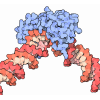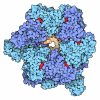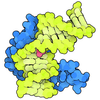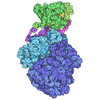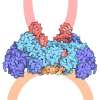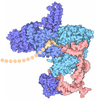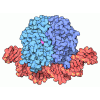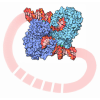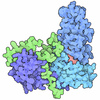+ Open data
Open data
- Basic information
Basic information
| Entry | Database: PDB / ID: 9eil | |||||||||||||||
|---|---|---|---|---|---|---|---|---|---|---|---|---|---|---|---|---|
| Title | SIRT6 bound to an H3K27Ac nucleosome | |||||||||||||||
 Components Components |
| |||||||||||||||
 Keywords Keywords | GENE REGULATION / nucleosome / SIRTUIN6 / histone deacylation / H3K27Ac | |||||||||||||||
| Function / homology |  Function and homology information Function and homology informationhistone H3K56 deacetylase activity, NAD-dependent / histone H3K18 deacetylase activity, NAD-dependent / ketone biosynthetic process / histone H3K9 deacetylase activity, hydrolytic mechanism / histone H3K9 deacetylase activity, NAD-dependent / protein delipidation / NAD+-protein-lysine ADP-ribosyltransferase activity / chromosome, subtelomeric region / regulation of lipid catabolic process / positive regulation of protein localization to chromatin ...histone H3K56 deacetylase activity, NAD-dependent / histone H3K18 deacetylase activity, NAD-dependent / ketone biosynthetic process / histone H3K9 deacetylase activity, hydrolytic mechanism / histone H3K9 deacetylase activity, NAD-dependent / protein delipidation / NAD+-protein-lysine ADP-ribosyltransferase activity / chromosome, subtelomeric region / regulation of lipid catabolic process / positive regulation of protein localization to chromatin / NAD+-protein-arginine ADP-ribosyltransferase activity / DNA damage sensor activity / NAD-dependent protein demyristoylase activity / NAD-dependent protein depalmitoylase activity / positive regulation of stem cell differentiation / negative regulation of D-glucose import / positive regulation of chondrocyte proliferation / transposable element silencing / cardiac muscle cell differentiation / NAD-dependent protein lysine deacetylase activity / protein acetyllysine N-acetyltransferase / pericentric heterochromatin formation / protein deacetylation / histone deacetylase activity, NAD-dependent / protein localization to site of double-strand break / positive regulation of blood vessel branching / negative regulation of glycolytic process / TORC2 complex binding / negative regulation of protein localization to chromatin / positive regulation of vascular endothelial cell proliferation / histone deacetylase regulator activity / negative regulation of protein import into nucleus / regulation of double-strand break repair via homologous recombination / regulation of protein secretion / positive regulation of double-strand break repair / DNA repair-dependent chromatin remodeling / positive regulation of stem cell proliferation / lncRNA binding / negative regulation of gene expression, epigenetic / NAD+-protein mono-ADP-ribosyltransferase activity / positive regulation of stem cell population maintenance / positive regulation of telomere maintenance / regulation of lipid metabolic process / negative regulation of cellular senescence / site of DNA damage / Transferases; Glycosyltransferases; Pentosyltransferases / negative regulation of transcription elongation by RNA polymerase II / NAD+ poly-ADP-ribosyltransferase activity / NAD+ binding / negative regulation of gluconeogenesis / positive regulation of fat cell differentiation / subtelomeric heterochromatin formation / pericentric heterochromatin / response to UV / regulation of protein localization to plasma membrane / nucleosome binding / enzyme regulator activity / nucleotidyltransferase activity / Transferases; Acyltransferases; Transferring groups other than aminoacyl groups / positive regulation of protein export from nucleus / determination of adult lifespan / circadian regulation of gene expression / base-excision repair / positive regulation of insulin secretion / regulation of circadian rhythm / protein destabilization / chromatin DNA binding / Pre-NOTCH Transcription and Translation / positive regulation of fibroblast proliferation / protein import into nucleus / structural constituent of chromatin / transcription corepressor activity / positive regulation of proteasomal ubiquitin-dependent protein catabolic process / nucleosome / heterochromatin formation / glucose homeostasis / double-strand break repair / nucleosome assembly / positive regulation of cold-induced thermogenesis / site of double-strand break / Processing of DNA double-strand break ends / damaged DNA binding / chromatin remodeling / protein heterodimerization activity / negative regulation of cell population proliferation / intracellular membrane-bounded organelle / chromatin binding / chromatin / endoplasmic reticulum / negative regulation of transcription by RNA polymerase II / protein homodimerization activity / DNA binding / zinc ion binding / nucleoplasm / nucleus Similarity search - Function | |||||||||||||||
| Biological species |  Homo sapiens (human) Homo sapiens (human)synthetic construct (others) | |||||||||||||||
| Method | ELECTRON MICROSCOPY / single particle reconstruction / cryo EM / Resolution: 3.2 Å | |||||||||||||||
 Authors Authors | Markert, J. / Wang, Z. / Cole, P. / Farnung, L. | |||||||||||||||
| Funding support |  United States, 4items United States, 4items
| |||||||||||||||
 Citation Citation |  Journal: J Biol Chem / Year: 2025 Journal: J Biol Chem / Year: 2025Title: Structural and enzymatic plasticity of SIRT6 deacylase activity. Authors: Zhipeng A Wang / Jonathan Markert / Samuel D Whedon / Maheeshi Yapa Abeywardana / Xinlei Sheng / Eunju Nam / Kwangwoon Lee / Maggie Chen / Amanda Waterbury / Yingming Zhao / Lucas Farnung / Philip A Cole /  Abstract: Sirtuin 6 (SIRT6) is an NAD-dependent protein deacylase that targets lysine residues in histones in the cell nucleus, where it helps maintain genome stability and links metabolism to epigenetic ...Sirtuin 6 (SIRT6) is an NAD-dependent protein deacylase that targets lysine residues in histones in the cell nucleus, where it helps maintain genome stability and links metabolism to epigenetic control. Dysregulation of SIRT6 is believed to be associated with aging and cancer, making it of pharmacological interest. In this study, we use cryo-EM and enzymology to explore SIRT6 preference and adaptability toward different nucleosomal substrates. We have visualized a trapped complex of SIRT6 in the process of deacylating H3K27, demonstrating how SIRT6 undergoes conformational changes to remove differently positioned histone marks. Additional biochemical studies further reveal the plasticity of SIRT6, which accommodates various metabolism-linked modifications, such as lysine lactylation and β-hydroxybutyrylation. To further understand the basis for substrate selectivity of SIRT6, we explore the effects of an established G60A enzyme mutation, proximal H3 modifications, and small-molecule modulators. These findings highlight the versatility of SIRT6 and provide key mechanistic insights into its molecular recognition. | |||||||||||||||
| History |
|
- Structure visualization
Structure visualization
| Structure viewer | Molecule:  Molmil Molmil Jmol/JSmol Jmol/JSmol |
|---|
- Downloads & links
Downloads & links
- Download
Download
| PDBx/mmCIF format |  9eil.cif.gz 9eil.cif.gz | 373.1 KB | Display |  PDBx/mmCIF format PDBx/mmCIF format |
|---|---|---|---|---|
| PDB format |  pdb9eil.ent.gz pdb9eil.ent.gz | 283.9 KB | Display |  PDB format PDB format |
| PDBx/mmJSON format |  9eil.json.gz 9eil.json.gz | Tree view |  PDBx/mmJSON format PDBx/mmJSON format | |
| Others |  Other downloads Other downloads |
-Validation report
| Arichive directory |  https://data.pdbj.org/pub/pdb/validation_reports/ei/9eil https://data.pdbj.org/pub/pdb/validation_reports/ei/9eil ftp://data.pdbj.org/pub/pdb/validation_reports/ei/9eil ftp://data.pdbj.org/pub/pdb/validation_reports/ei/9eil | HTTPS FTP |
|---|
-Related structure data
| Related structure data |  48086MC M: map data used to model this data C: citing same article ( |
|---|---|
| Similar structure data | Similarity search - Function & homology  F&H Search F&H Search |
- Links
Links
- Assembly
Assembly
| Deposited unit | 
|
|---|---|
| 1 |
|
- Components
Components
-Protein , 5 types, 9 molecules AEBFCGDHK
| #1: Protein | Mass: 15271.863 Da / Num. of mol.: 2 Source method: isolated from a genetically manipulated source Source: (gene. exp.)  #2: Protein | Mass: 11263.231 Da / Num. of mol.: 2 Source method: isolated from a genetically manipulated source Source: (gene. exp.)  #3: Protein | Mass: 13978.241 Da / Num. of mol.: 2 Source method: isolated from a genetically manipulated source Source: (gene. exp.)  #4: Protein | Mass: 13524.752 Da / Num. of mol.: 2 Source method: isolated from a genetically manipulated source Source: (gene. exp.)  #7: Protein | | Mass: 39152.863 Da / Num. of mol.: 1 Source method: isolated from a genetically manipulated source Source: (gene. exp.)  Homo sapiens (human) / Gene: SIRT6, SIR2L6 / Production host: Homo sapiens (human) / Gene: SIRT6, SIR2L6 / Production host:  References: UniProt: Q8N6T7, Transferases; Acyltransferases; Transferring groups other than aminoacyl groups, protein acetyllysine N-acetyltransferase, Transferases; Glycosyltransferases; Pentosyltransferases |
|---|
-DNA chain , 2 types, 2 molecules IJ
| #5: DNA chain | Mass: 57400.559 Da / Num. of mol.: 1 / Source method: obtained synthetically / Source: (synth.) synthetic construct (others) |
|---|---|
| #6: DNA chain | Mass: 56831.191 Da / Num. of mol.: 1 / Source method: obtained synthetically / Source: (synth.) synthetic construct (others) |
-Non-polymers , 2 types, 2 molecules 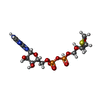


| #8: Chemical | ChemComp-ZSL / [( |
|---|---|
| #9: Chemical | ChemComp-ZN / |
-Details
| Has ligand of interest | Y |
|---|---|
| Has protein modification | Y |
-Experimental details
-Experiment
| Experiment | Method: ELECTRON MICROSCOPY |
|---|---|
| EM experiment | Aggregation state: PARTICLE / 3D reconstruction method: single particle reconstruction |
- Sample preparation
Sample preparation
| Component | Name: SIRT6 bound to H3K27Ac / Type: COMPLEX / Entity ID: #1-#7 / Source: MULTIPLE SOURCES |
|---|---|
| Molecular weight | Experimental value: NO |
| Buffer solution | pH: 7.5 |
| Specimen | Embedding applied: NO / Shadowing applied: NO / Staining applied: NO / Vitrification applied: YES |
| Vitrification | Cryogen name: ETHANE |
- Electron microscopy imaging
Electron microscopy imaging
| Experimental equipment |  Model: Titan Krios / Image courtesy: FEI Company |
|---|---|
| Microscopy | Model: TFS KRIOS |
| Electron gun | Electron source:  FIELD EMISSION GUN / Accelerating voltage: 300 kV / Illumination mode: OTHER FIELD EMISSION GUN / Accelerating voltage: 300 kV / Illumination mode: OTHER |
| Electron lens | Mode: BRIGHT FIELD / Nominal defocus max: 1700 nm / Nominal defocus min: 700 nm |
| Image recording | Electron dose: 50.45 e/Å2 / Film or detector model: GATAN K3 BIOQUANTUM (6k x 4k) |
- Processing
Processing
| EM software | Name: PHENIX / Category: model refinement | ||||||||||||||||||||||||
|---|---|---|---|---|---|---|---|---|---|---|---|---|---|---|---|---|---|---|---|---|---|---|---|---|---|
| CTF correction | Type: PHASE FLIPPING AND AMPLITUDE CORRECTION | ||||||||||||||||||||||||
| 3D reconstruction | Resolution: 3.2 Å / Resolution method: FSC 0.143 CUT-OFF / Num. of particles: 124274 / Symmetry type: POINT | ||||||||||||||||||||||||
| Atomic model building | Protocol: RIGID BODY FIT / Space: REAL | ||||||||||||||||||||||||
| Refine LS restraints |
|
 Movie
Movie Controller
Controller



 PDBj
PDBj